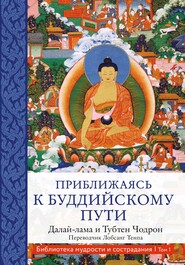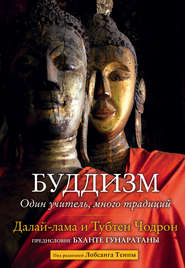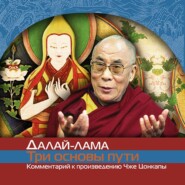По всем вопросам обращайтесь на: info@litportal.ru
(©) 2003-2024.
✖
The Four Noble Truths
Автор
Год написания книги
2018
Настройки чтения
Размер шрифта
Высота строк
Поля
So Shariputra sought out the Buddha straightaway, arguing that if Manjushri had let him guide these five hundred people, they would have at least attained high levels of realization, if not full enlightenment. The Buddha responded by saying that in fact Manjushri had applied the principle of skilful means. Manjushri knew that in the short term these people would create negative actions through their wrong views, but he also knew that because the doctrine of emptiness had been implanted in their consciousness, those seeds would later ripen and would lead them to buddhahood. So in effect, their path to buddhahood had been shortened.
The moral that we can draw from this story is that until we reach the state of full enlightenment ourselves, it is very difficult to judge what is, and what is not, the right response to a given situation. We should simply do our best to be sensitive to each particular situation when we are interacting with others.
Q: Your Holiness, it is a well-known fact that you are a very busy person with many demands on your time. Could you advise a lay person with home, family and work demands, on how to develop a systematic pattern of Dharma practice?
HHDL: My Western friends often ask me for the quickest, easiest, most effective – and cheapest – way of practising Dharma! I think to find such a way is impossible! Maybe that is a sign of failure!
We should realize that practising the Dharma is actually something that needs to be done twenty-four hours of the day. That’s why we make a distinction between actual meditation sessions and post-meditation periods, the idea being that both while you are in the meditative session and also when you are out of it, you should be fully within the realm of Dharma practice.
In fact, one could say that the post-meditation periods are the real test of the strength of your practice. During formal meditation, in a sense you are recharging your batteries, so that when you come out of the session you are better equipped to deal with the demands of your everyday life. The very purpose of recharging a battery is to enable it to run something, isn’t it? Similarly, once you have equipped yourself through whatever practices you engage in, as a human being you can’t avoid the daily routines of life, and it is during these periods that you should be able to live according to the principles of your Dharma practice.
Of course at the initial stage, as a beginner, you do need periods of concentrated meditation so that you have a base from which you can begin. This is certainly crucial. But once you have established that base, then you will be able to adopt a way of life where your daily activity is at least in accord with the principles of the Dharma. So all this points to the importance of making an effort. Without some effort, there is no way that we can integrate the principles of Dharma in our lives.
For a serious practitioner, the most serious effort is necessary. Just a few short prayers, a little chanting, and some mantra recitation with a mala (rosary) are not sufficient. Why not? Because this cannot transform your mind. Our negative emotions are so powerful that constant effort is needed in order to counteract them. If we practise constantly, then we can definitely change.
Q: What is the relationship between relative compassion and absolute compassion?
HHDL: There are different ways of understanding the meaning of compassion according to whether you approach it from the Mahayana or the Vajrayana point of view. For example, although the Vajrayana uses the same word for compassion, karuna, as the Mahayana, it has a totally different meaning.
Perhaps this question is related to another distinction made in the scriptures between two levels of compassion. At the first level, compassion is simulated. This is the initial stage, when you need to practise certain contemplations in order to generate compassion. As a result of this practice you reach the second level, at which compassion becomes natural and spontaneous. This is one of the ways of understanding the difference between relative and absolute compassion.
ONE
INTRODUCING THE FOUR NOBLE TRUTHS (#ulink_e5cd8c61-722b-5037-a990-d39a8155a568)
Now let us turn to the Buddhist teaching on the Four Noble Truths. The first question we might ask is why these Truths are considered to be so fundamental, and why, in fact, Buddha taught them at all.
In order to answer this, we have to relate the Four Noble Truths to our own experience as individual human beings. It is a fact – a natural fact of life – that each one of us has an innate desire to seek happiness and to overcome suffering. This is something very instinctive, and there is no need to prove it is there. Happiness is something that we all aspire to achieve, and of course we naturally have a right to fulfil that aspiration. In the same way, suffering is something everybody wishes to avoid, and we also have the right to try to overcome suffering. So if this aspiration to achieve happiness and overcome suffering is our natural state of being, and our natural quest, the question is how we should go about fulfilling that aspiration.
This leads us to the teachings on the Four Noble Truths, which provide an understanding of the relationship between two sets of events: causes and their effects. On one side we have suffering, but suffering does not come from nowhere, it arises as a result of its own causes and conditions. On the other side we have happiness, which also arises from its own particular set of causes and conditions.
Now when we speak of happiness in Buddhism, our understanding of it is not confined to a state of feeling. Certainly cessation (the total cessation of suffering) is not a state of feeling, and yet we could say that cessation is the highest form of happiness because it is, by definition, complete freedom from suffering. Here again cessation, or true happiness, does not come into being from nowhere or without any cause. This is a subtle point, of course, because from the Buddhist perspective cessation is not a conditioned event, so it cannot be said to be actually produced, or caused, by anything. However, the actualization or attainment of cessation does depend on the path and on an individual’s effort. You cannot attain cessation without making an effort. In this sense we can therefore say that the path that leads to cessation is the cause of cessation.
The teachings on the Four Noble Truths clearly distinguish two sets of causes and effects: those causes which produce suffering, and those which produce happiness. By showing us how to distinguish these in our own lives, the teachings aim at nothing less than to enable us to fulfil our deepest aspiration – to be happy and to overcome suffering.
Once we have realized that this is why Buddha taught the Four Noble Truths, we might go on to ask ourselves the reason for their specific sequence: why are the Four Noble Truths taught in a particular order, starting with suffering, continuing with the origin of suffering, and so on? On this point we should understand that the order in which the Four Noble Truths are taught has nothing to do with the order in which things arise in reality. Rather, it is related to the way an individual should go about practising the Buddhist path, and attain realizations based on that practice.
In the Uttaratantra, Maitreya states that there are four stages to curing an illness.
Just as the disease need be diagnosed, its cause eliminated, a healthy state achieved and the remedy implemented, so also should suffering, its causes, its cessation and the path be known, removed, attained and undertaken.
(#litres_trial_promo)
Maitreya uses the analogy of a sick person to explain the way in which realizations based on the Four Noble Truths can be attained. In order for a sick person to get well, the first step is that he or she must know that he is ill, otherwise the desire to be cured will not arise. Once you have acknowledged that you are sick, then naturally you will try to find out what led to it and what makes your condition even worse. When you have identified these, you will gain an understanding of whether or not the illness can be cured, and a wish to be free from the illness will arise in you. In fact this is not just a mere wish, because once you have recognized the conditions that led to your illness, your desire to be free of it will be much stronger since that knowledge will give you a confidence and conviction that you can overcome the illness. With that conviction, you will want to take all the medications and remedies necessary.
Вы ознакомились с фрагментом книги.
Приобретайте полный текст книги у нашего партнера:
Приобретайте полный текст книги у нашего партнера:

















